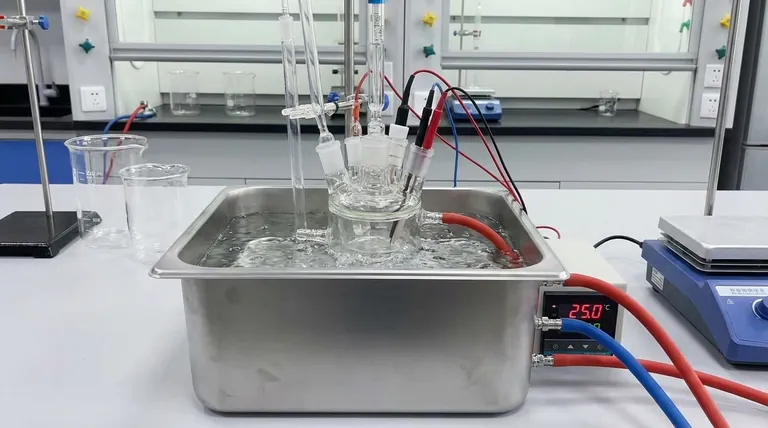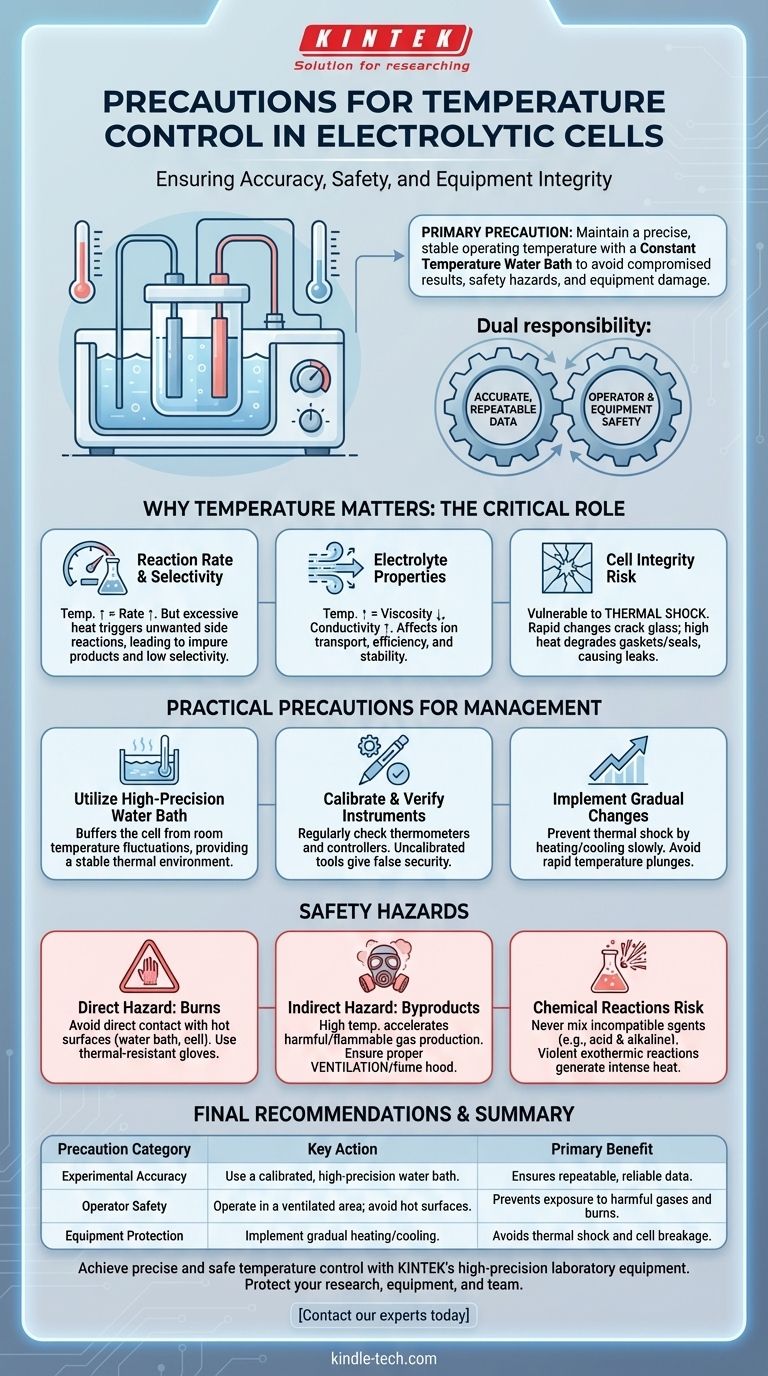The primary precaution for an electrolytic cell is to maintain a precise and stable operating temperature using a constant temperature water bath. Both excessively high and low temperatures can compromise your experimental results, create safety hazards, and potentially cause irreversible damage to the cell itself.
Temperature control is not a single action but a dual responsibility: it is essential for achieving accurate, repeatable experimental data and for ensuring the physical safety of both the operator and the equipment.

The Critical Role of Temperature in Electrolysis
To manage temperature effectively, you must first understand why it is so crucial. Temperature is an active parameter that directly influences the electrochemical system's behavior and integrity.
Impact on Reaction Rate and Selectivity
The speed of most electrochemical reactions increases with temperature. While this can be desirable, excessive heat can also trigger unwanted side reactions.
This loss of selectivity means your process may generate impure products or unexpected byproducts, compromising the validity of your experiment.
Influence on Electrolyte Properties
Temperature directly alters the physical properties of the electrolyte. An increase in temperature typically decreases viscosity and increases ionic conductivity.
These changes affect ion transport within the cell, influencing the overall efficiency and power consumption of the electrolytic process. Uncontrolled fluctuations lead to an unstable system.
Risk to Cell Integrity
The electrolytic cell body is often made of glass, which is vulnerable to thermal shock. Rapid heating or cooling can cause the glass to crack or shatter.
Furthermore, high temperatures can degrade other cell components, such as gaskets, seals, or membranes, leading to leaks and premature equipment failure.
Practical Precautions for Temperature Management
Effective temperature control relies on using the right tools and procedures. Simply setting a target is not enough; you must ensure the system maintains it accurately.
Utilize a High-Precision Water Bath
A constant temperature water bath is the standard apparatus for this task. It provides a stable thermal environment, buffering the electrolytic cell from fluctuations in ambient room temperature.
Calibrate and Verify Your Instruments
Your control system is only as reliable as its sensors. You must regularly check and calibrate the thermometer and temperature controller of the water bath.
An uncalibrated instrument can provide a false sense of security, leading you to operate at an incorrect temperature without realizing it.
Implement Gradual Temperature Changes
To prevent thermal shock, always heat and cool the system slowly and gradually. Avoid plunging a cold cell into a hot water bath or vice versa.
Understanding the Safety Hazards
Poor temperature control introduces significant risks beyond just inaccurate data. It creates direct threats to personal safety and the lab environment.
The Direct Hazard of High Temperatures
The most immediate danger is burns. The water bath apparatus and the electrolytic cell itself can reach high temperatures. Avoid direct contact with these surfaces.
Always be aware of the system's operating temperature and handle components with appropriate care or thermal-resistant gloves if necessary.
The Indirect Hazard of Reaction Byproducts
High temperatures can accelerate the production of harmful or flammable gases during electrolysis.
This makes proper ventilation a critical safety measure. Always operate the electrolytic cell in a well-ventilated area or under a fume hood, especially when dealing with unknown reactions or high temperatures.
The Risk of Chemical Reactions
Never use incompatible cleaning agents, like mixing acid and alkaline solutions. This can cause a violent exothermic reaction, generating intense heat and posing a significant danger.
Final Recommendations for Your Experiment
Your approach to temperature control should be tailored to your primary objective.
- If your primary focus is experimental accuracy: Prioritize the use of a calibrated, high-precision water bath to ensure temperature stability and repeatability.
- If your primary focus is personal safety: Always operate in a well-ventilated area, be mindful of hot surfaces to prevent burns, and use appropriate personal protective equipment (PPE).
- If your primary focus is protecting your equipment: Handle the glass cell gently and avoid rapid temperature changes to prevent thermal shock and breakage.
Mastering temperature control is fundamental to achieving safe, successful, and repeatable results in electrolysis.
Summary Table:
| Precaution Category | Key Action | Primary Benefit |
|---|---|---|
| Experimental Accuracy | Use a calibrated, high-precision water bath | Ensures repeatable, reliable data |
| Operator Safety | Operate in a ventilated area; avoid hot surfaces | Prevents exposure to harmful gases and burns |
| Equipment Protection | Implement gradual heating/cooling | Avoids thermal shock and cell breakage |
Achieve precise and safe temperature control in your lab. KINTEK specializes in high-precision laboratory equipment, including constant temperature water baths and electrolytic cells, designed to deliver the stability and accuracy your experiments demand. Protect your research, your equipment, and your team. Contact our experts today to find the perfect solution for your laboratory needs.
Visual Guide

Related Products
- Double Layer Five-Port Water Bath Electrolytic Electrochemical Cell
- Electrolytic Electrochemical Cell with Five-Port
- Quartz Electrolytic Electrochemical Cell for Electrochemical Experiments
- Double-Layer Water Bath Electrolytic Electrochemical Cell
- Electrolytic Electrochemical Cell for Coating Evaluation
People Also Ask
- When is chemical cleaning necessary for an electrolytic cell, and how should it be performed? A Guide to Removing Stubborn Deposits
- How should the electrolytic cell be secured on the stand during an experiment? A Step-by-Step Guide for Stability
- What is the applicable temperature range for the electrolytic cell and how is the temperature controlled? Achieve Precise Electrochemical Results
- How should faults with the electrolytic cell be handled? A Guide to Safe Diagnosis and Repair
- What inspection steps should be performed before using the electrolytic cell? A Guide to Safe & Accurate Experiments



















